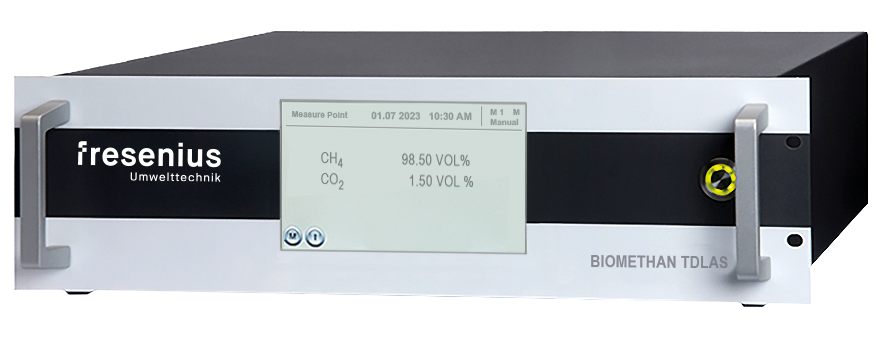
Front view
Biomethane TDLAS
The Gas Analyzer Biomethane TDLAS was specially developed for the precise online measurement of high methane concentrations, as they occur in biomethane and natural gas processes. Thanks to TDLAS technology (Tunable Diode Laser Spectroscopy), the device delivers fast and reliable measurement results even under demanding conditions.
The Gas Analyzer Biomethane TDLAS is specially designed for the precise measurement of high methane concentrations (CH₄), as they occur in biomethane and natural gas processes. The innovative TDLAS technology ensures fast and reliable online measurements, even at concentrations of 80-100% by volume. The device is immune to cross-sensitivities and thus enables precise analysis without being influenced by other gas components. Thanks to its robustness, the biomethane TDLAS is ideal for use in demanding process environments and supports a wide range of applications in gas analysis.
- Precise measurement: Developed for maximum accuracy at methane concentrations of 80-100% by volume.
- Cross-sensitivity-free: No interference from other gases - ideal results in any environment.
- TDLAS technology: State-of-the-art laser technology for reliable and fast analysis.
- High efficiency: Minimal maintenance and low operating costs.
- Automatic zero point correction: Long-lasting precision thanks to patented temperature compensation.
- Intuitive operation: Convenient touch display for easy navigation.
- Flexible expandability: One sample gas inputs (standard), expandable to up to 8 inputs.
The Gas Analyzer Biomethane TDLAS is used in the most important areas of the biogas and natural gas industry:
- Biomethane CHPs: Optimal methane analysis for maximum energy efficiency.
- Biomethane plants: Ensuring gas quality before feeding it into the grid.
- Natural gas network: Monitoring and control of gas compositions for network conformity.
- Power-to-gas plants: Precise process monitoring for the conversion of renewable energies.
- Measuring ranges: CH₄: 0-100 vol.-% (optimized for 80-100 vol.-%).
- Measuring accuracy: ±0.1 % of measured value, precision: ±0.03 % by volume, resolution: 0.01 % by volume.
- Measurement technology: TDLAS (Tunable Diode Laser Spectroscopy), cross-sensitivity-free.
- Connections: 1 sample gas inputs (standard), expandable to up to 8.
- Gas flow rate: approx. 1 l/min, pressure range 0.8-1.2 bar (compensated).
- Operating voltage: 230 V AC / 50 Hz (alternatively 115 V AC / 60 Hz).
- Housing: 19" plug-in unit (IP 20), depth 400 mm.
- Communication: RS232 (standard); optional Profibus DP, Ethernet TCP/IP, Profinet.
Advantages
Precise methane measurement
Thanks to the innovative TDLAS technology, the biomethane TDLAS delivers precise and reliable results even at methane concentrations of 80-100 % by volume. The measurement is carried out without cross-sensitivity and with an accuracy of ±0.1 % of the measured value.

Efficient and low-maintenance
The Gas Analyzer minimizes your maintenance costs thanks to the automatic zero point correction and durable components. This reduces operating costs and ensures high availability of your system.

Flexibility and easy integration
With up to 8 expandable sample gas inputs and optional interfaces such as Ethernet or Profibus, the biomethane TDLAS can be perfectly integrated into existing systems. The intuitive touch display ensures simple operation.

FAQ
Why does it make economic sense to measure the methane content, and why is it even more advantageous with TDLAS?
Measuring the methane content is crucial to ensure that your biomethane meets the required quality standards - whether for feeding into the natural gas grid, use as a fuel or other applications. Accurate measured values allow you to optimize your processes, maximize methane yield and reduce operating costs. Inaccurate or delayed measurements, on the other hand, can lead to quality losses, system malfunctions or additional costs.
TDLAS technology offers decisive economic advantages that other technologies such as NDIR measurement technology do not achieve:
- Real-time measurements: With a measurement frequency of up to one value per second, TDLAS provides continuous data that enables immediate adjustments to be made in your processes. This is a significant advantage, especially in dynamic systems such as methane processing or feed-in.
- Greater accuracy and stability: While NDIR can generally be affected by cross-sensitivities or optical contamination, TDLAS remains accurate even under demanding conditions. This reduces the need for corrections and manual intervention.
- Increased efficiency through process control: Thanks to the rapid availability of data, you can identify problems or fluctuations at an early stage and take countermeasures before production losses occur. This is often not possible with slower technologies.
- Ease of maintenance: TDLAS requires less calibration and no regular filter changes, which saves time and money. In addition, there are no measurement deviations due to ageing of optical components.
What advantages does TDLAS offer over other technologies?
The laser-based TDLAS technology requires less maintenance, delivers extremely precise results and is cross-sensitivity-free. This reduces operating costs and maximizes the productivity of your plant, especially in applications with high methane concentrations. Compared to NDIR, TDLAS is more precise and reliable, avoiding errors and minimizing economic losses.
How does the biomethane TDLAS contribute to long-term savings?
The high measuring accuracy and stability not only save you calibration costs, but also operating costs through the efficient use of your resources. The low maintenance requirements and the long service life of the components make the device an extremely economical investment.
Can I increase the methane content with the biomethane TDLAS?
Yes, precise measurements of the methane content make it possible to optimize your processes and maximize the methane yield. This increases your revenue by producing high-quality biomethane.
What makes TDLAS particularly valuable for biogas plants?
TDLAS technology delivers reliable results, especially in applications with high methane concentrations, without impurities or cross-sensitivities affecting the measured values. This is crucial to ensure consistent quality and efficiency.
Is the Gas Analyzer easy to use?
The intuitive touch display allows you to monitor all important measurement data in real time. The robust design and minimal maintenance requirements ensure that your system runs smoothly.
How does TDLAS technology differ from NDIR measurement technology?
TDLAS technology uses laser-based spectroscopy to specifically detect individual molecules without cross-sensitivities. Compared to NDIR (non-dispersive infrared spectroscopy) technology, TDLAS offers significantly more precise results at high methane concentrations (80-100% by volume) and requires less maintenance as there are no optical filters to foul. NDIR is more suitable for lower concentrations and applications with less specific requirements.
What are the calibration requirements for TDLAS?
TDLAS technology eliminates the need for regular recalibration, as the automatic zero point correction ensures long-term stable measurements. This saves maintenance time and costs compared to other technologies.
How quickly does the analyzer deliver measurement results?
TDLAS technology works almost in real time and has an integration time of 1 second. This enables precise and fast adaptation of your processes.
Well? Interested?
Contact us for comprehensive advice - holistic and solution-oriented.

Fresenius Umwelttechnik GmbH
Office hours
Time zone CEST
The company
Contact us
© 2024 Fresenius Umwelttechnik GmbH

